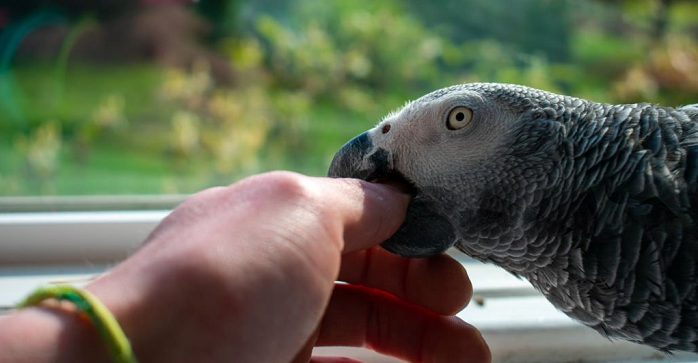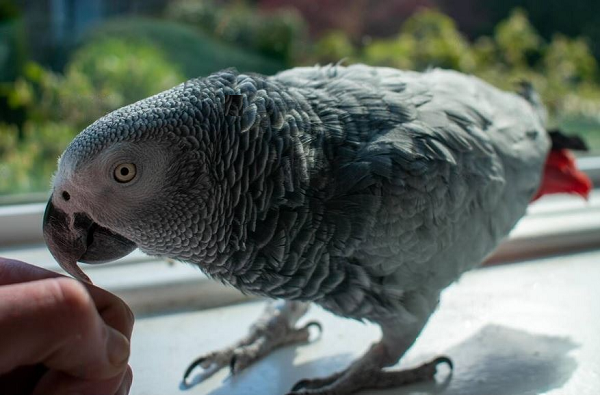Do you have any experience about ‘African Grey bite’? You are not single one; most of people having experience African grey parrot bite at least one. The great news for you about African Greys doesn’t bit in the wild. They are not known for biting to other birds.
Whenever your parrot bites you, then you get a confusing and unsettling experience. Because, you are the one who do care for your beloved parrot day in and day out; and nourishing without any unconditional. Therefore, you feel like as a slap on face, when your colorful parrot unexpectedly bites you.
Be calm! Don’t confuse! From this article, we will show you all things about African Grey bite along with its strength. And why they try to it. As well as, you will also look about how do you prevent and reduce the biting risk.
Do African Grey Parrots Bite Hurt?
Yes! African Grey bird bites can easily hurt you. These parrots have strong beaks that established to crack open nuts and seeds. So, it can exert significant pressure by their bites.
The getting pain from a bite can sharp pinch or piercing sensation. But, it depends on the intensity and location of the bite.
Some time, a bite can break the skin and get bleeding, potentially leading to infections if not do properly treatment. Besides of this, African Grey Parrots bit can get bruising and swelling.
So, you should understand that why these birds bite and underlying causes, such as fear, stress, or territorial behavior, to prevent future incidents.

To reduce the likelihood of biting, do building trust, proper training, and ensuring a safe and enriching environment. You have to make healthy relationship between you and your parrot.
Why African Grey Parrots Bite? Valid Reasons
African Grey Parrots may bite for various valid reasons, including:
Fear and Anxiety
African Grey Parrots are highly sensitive and can easily become frightened. Fear-induced biting is a common response to perceived threats. Factors contributing to fear and anxiety include:
Sudden Movements: Unexpected actions or quick movements can startle these birds.
Unfamiliar People or Animals: New faces or other pets in the household can be intimidating.
New Environments: Changes in surroundings or the introduction of new objects can create uncertainty and stress.
Territorial Behavior
African Greys are known to be territorial, particularly around their cage. This behavior is driven by:
Defending Personal Space: The cage is their sanctuary, and any perceived intrusion can trigger a defensive bite.
Protective Instincts: They may feel the need to protect their food, toys, and nesting areas.
Hormonal Changes
During breeding seasons, African Greys undergo hormonal fluctuations that get increased aggression. This behavior is natural and includes:
Also Read: Where Do Parrots Live? Exploring Their Diverse Habitats
Breeding Season Aggression: Hormones can make them more protective and irritable.
Mating Behavior: They might bite to assert dominance or as part of courtship rituals.
Lack of Socialization
Proper socialization is crucial for African Greys. Without it, they may develop mistrust and fear toward humans:
Negative Past Experiences: Birds that have experienced neglect or abuse may prone to biting.
Inadequate Interaction: Lack of positive interactions can result in fear-based biting.
Stress and Frustration
African Greys need mental stimulation and a stable environment. Stress and frustration can also lead to biting, often due to:
Changes in Routine: Parrots thrive on consistency, and disruptions can cause anxiety.
Lack of Enrichment: If, they feel boredom then can frustration bites. So, offer toys, puzzles, and make interaction them.
Environmental Stressors: Loud noises or overcrowded living spaces can contribute to stress.
Attention-Seeking
Some African Greys learn that biting gets them attention, even if it’s negative. This behavior can reinforce if:
Reactions to Biting: If owners consistently react strongly to bites, bird may use biting as a way to engage.
Lack of Positive Attention: Insufficient social interaction can lead them attention through biting.
Health Issues
Biting can be a sign of health problems. Pain or discomfort often leads to irritability and aggression:
Illness or Injury: Arthritis, infections, or injuries can cause pain, prompting a defensive bite.
Regular Veterinary Care: Regular check-ups to identify and address health issues promptly.
Improper Handling
Improper handling can cause African Greys to bite as a defensive measure:
Rough Handling: Being handled too roughly can make them feel threatened.
Invasion of Personal Space: Not respecting their boundaries can lead to defensive biting.
Protective Instincts
African Greys can protect of their perceived flock and their human family:
Perceived Threats: They might bite to protect their owners from perceived dangers.
Defensive Aggression: This is more common when they form a strong bond with one person.
Exploration and Curiosity
Young African Greys use their beaks to explore their environment. This type of biting is often not aggressive:
Exploratory Behavior: They use their beaks to learn about their surroundings. As similar to how toddlers use their hands and mouths.
Accidental Biting: While not intended to harm, exploratory bites can still be painful.
African Grey Bite Force Comparison with Other
Also Read: Do Cockatiels Talk? A Guide to Their Vocal Talents
| Parrot Species | Bite Force (PSI) |
|---|---|
| African Grey Bite | 300-350 PSI |
| Macaw | 350-700 PSI |
| Cockatoo | 350-400 PSI |
| Amazon Parrot | 200-300 PSI |
| Eclectus Parrot | 150-200 PSI |
| Conure | 100-150 PSI |
| Lovebird | 50-100 PSI |
| Budgerigar (Budgie) | 20-30 PSI |
Note: PSI stands for pounds per square inch and is a measure of pressure. The bite force values are approximate. It can vary depending on individual parrots and measurement conditions.
Can African Grey Parrot Bite Your Finger Off?
No! It has less probability that an African Grey parrot can bite off your finger, despite do their powerful bites. African Grey parrot has a bite force ranging from 300 to 500 pounds per square inch (psi).
It is significantly stronger as compared to the average human bite of 162 psi. Their beak anatomy is designed for cracking nuts and manipulating objects, not hurting.
African Grey bites can get certainly severe injury, then need medical attention. Completely biting off a finger would be an exceptionally case, even under extreme circumstances.
Recognize the warning signs of an impending bite and avoid triggering situations. With proper handling and good relationship, you can minimize the risk of an African Grey inflicting.
What To Do If African Grey Bite You?
If an African Grey Parrot bites you, here’s what you should do:
Also Read: Can Parrotlets Talk? Myth or Reality
Remain Calm: Reacting with fear or aggression can escalate the situation. Stay calm to avoid further stressing the bird.
Say Firmly, “No”: Use calm but firm voice to let the parrot know that biting is not acceptable.
Withdraw Slowly: Gently withdraw of affected body part from the parrot’s grasp. It gets minimize the risk of a second bite.
Provide Distraction: Offer a favorite toy or treat to redirect the bird’s attention away from the biting.
Assess the Injury: Check for any wounds or bleeding. Now, should be clean the area with mild soap and water. Apply an antiseptic if necessary.
Monitor for Infection: Watch for signs of infection such as redness, swelling, or warmth around the bite. Take medical attention if required.
Reflect on the Cause: Consider what triggered the bite to prevent future incidents through training and environmental adjustments.
How Do You Train an African Grey Not to Bite?
You have to patience and consistency, to train African Grey Parrot not to bite. Here’s a step-by-step approach:
Prevention Strategies Are:
Understand the Reason: Identify why your parrot is biting (e.g., fear, territoriality) to tailor your approach accordingly.
Build Trust: Spend quality time bonding with parrot through gentle interactions and positive reinforcement. Due to this, make healthy trust and reduces fear level.
Learn Body Language: Recognize signs of discomfort or agitation to anticipate. Should be avoid this situations that can lead to biting.
Positive Reinforcement: Reward calm and non-biting behavior with treats, praise, or attention.
Desensitization: Gradually expose your parrot to situations that trigger biting in a controlled manner. But, you should patience and their reward incremental progress.
Redirect Attention: If you sense your parrot is becoming agitated or aggressive, distract them with a favorite toy or activity to redirect their focus.
Consistent Responses: React calmly and consistently to biting incidents. Avoid yelling or punishing, as this can worsen behavior and erode trust.
Training Commands: You should teach some basic commands like “step up” and “step down” to make boundaries and controllable interactions.
Professional Help: Consider consulting a certified parrot behaviorist for personalized guidance if biting persists despite your efforts.
Can African Grey Bites Cause Infection?
Yes! Bites from African Grey Parrots can potentially lead to infections. Their bites are not able to typically sever fingers or cause major injuries.
Also Read: Can Macaws Talk? Exploring Macaw Vocalizations
But, they have ability to puncture the skin sufficiently to spread bacteria from their beaks or surroundings into the wound. If you don’t clean minor puncture wounds, then can become infected.
The beaks of African Greys can produce bacteria from their food, environment, or even from their own mouths.
Some factors also affect likelihood and severity of infection like as the depth of bite and overall health of the person.
You should clean the wound thoroughly with mild soap and water, then can apply an antiseptic. Must be keep monitoring for any signs of infection, such as redness or swelling.
Take medical assistance quickly, if the wound shows signs of infection or does not heal properly.
African Grey Bite: Warning Signs
Here are some key warning signs that an African Grey parrot may bite:
Pinning Eyes: The bird’s pupils constrict to small pinpoints, indicating stress or aggression
Tail Fanning: The bird spreads its tail feathers out wide. It shows a sign of aggression or fear.
Feather Fluffing: The bird puffs out its feathers, making itself look larger. This is a defensive sign.
Head Bobbing: The bird moves its head back and forth in a jerky motion that often precedes a bite
Lunging: The bird suddenly lurches forward with a loud squawk, as a warning before biting.
Beak Grinding: The bird grinds its upper and lower beak together to create an audible grinding sound. This is an indication of stress or aggression.
Dilated Pupils: Dilated pupils can indicate fear or uncertainty.
Avoiding Eye Contact: The bird turns its head away and refuses to look at you directly
Backing Up: The bird walks backwards, often while fanning its tail, as a way to create distance before biting.
Freezing: The bird becomes very still and quiet. It can be a sign it is about to bite.
FAQs (Frequently Asked Questions)
Are All African Grey Parrots Prone to Biting?
Not all African Grey parrots bite. It is a common behavior that can occur in individuals, especially if they are stressed or poorly socialized.
How Can I Prevent My African Grey from Biting?
- Socialize your parrot well from a young age
- Apply the positive reinforcement training techniques
- Respect their boundaries and body language
What is Injection for African Grey Parrot Bite?
The injection typically administered for African Grey parrot bites is a tetanus toxoid vaccine. This vaccine aids to prevent tetanus infection that can occur from bacteria entering the body through a puncture wound like a bite. If, African Greys bit anyone, then take prompt medical treatment as necessary.
Should I Punish My African Grey Parrot for Biting?
If, you give punishment for biting behavior, it can worst and break a trust. Besides of this, should be focus on positive reinforcement and understanding the reasons behind the biting.
At The Final
As result of this article, you get to know about African Grey birds have a very powerful bite. Whenever they bit someone, then can get severe injury or wound.
Now, we hope that you have fully educated about potential reasons behind African Grey’s biting behavior, proper identify the warning signs agitation, and positive training techniques.
Also Read: Do Cockatoos Talk? Talking Abilities of Cockatoos
If this post is valuable for you, then please share it along with your friends, family members, pet lovers or relatives over social media platforms like as Facebook, Instagram, Linked In, Twitter, and more.
Do you have any experience, tips, tricks, or query regarding on this? You can drop a comment!
Have a Nice Day!!







